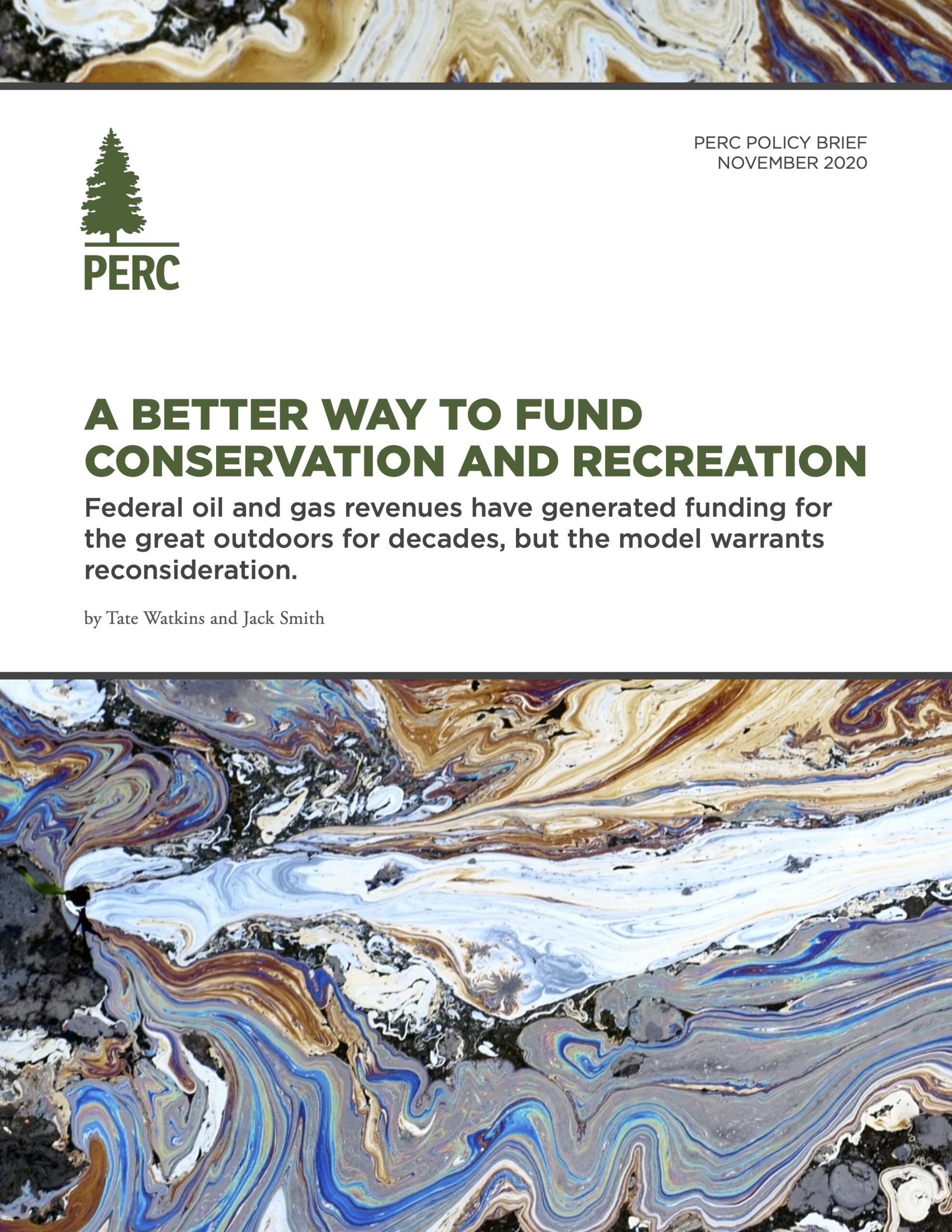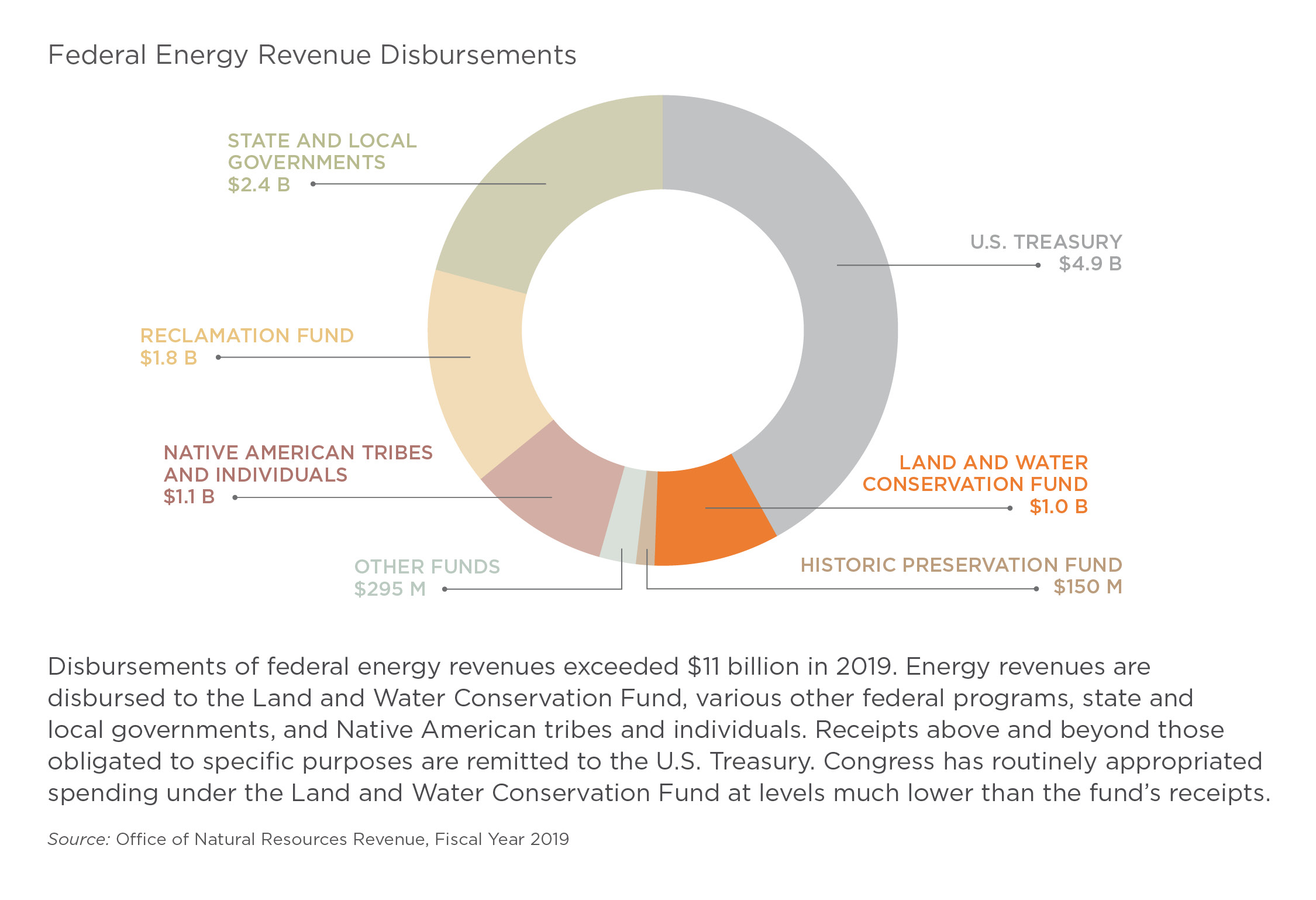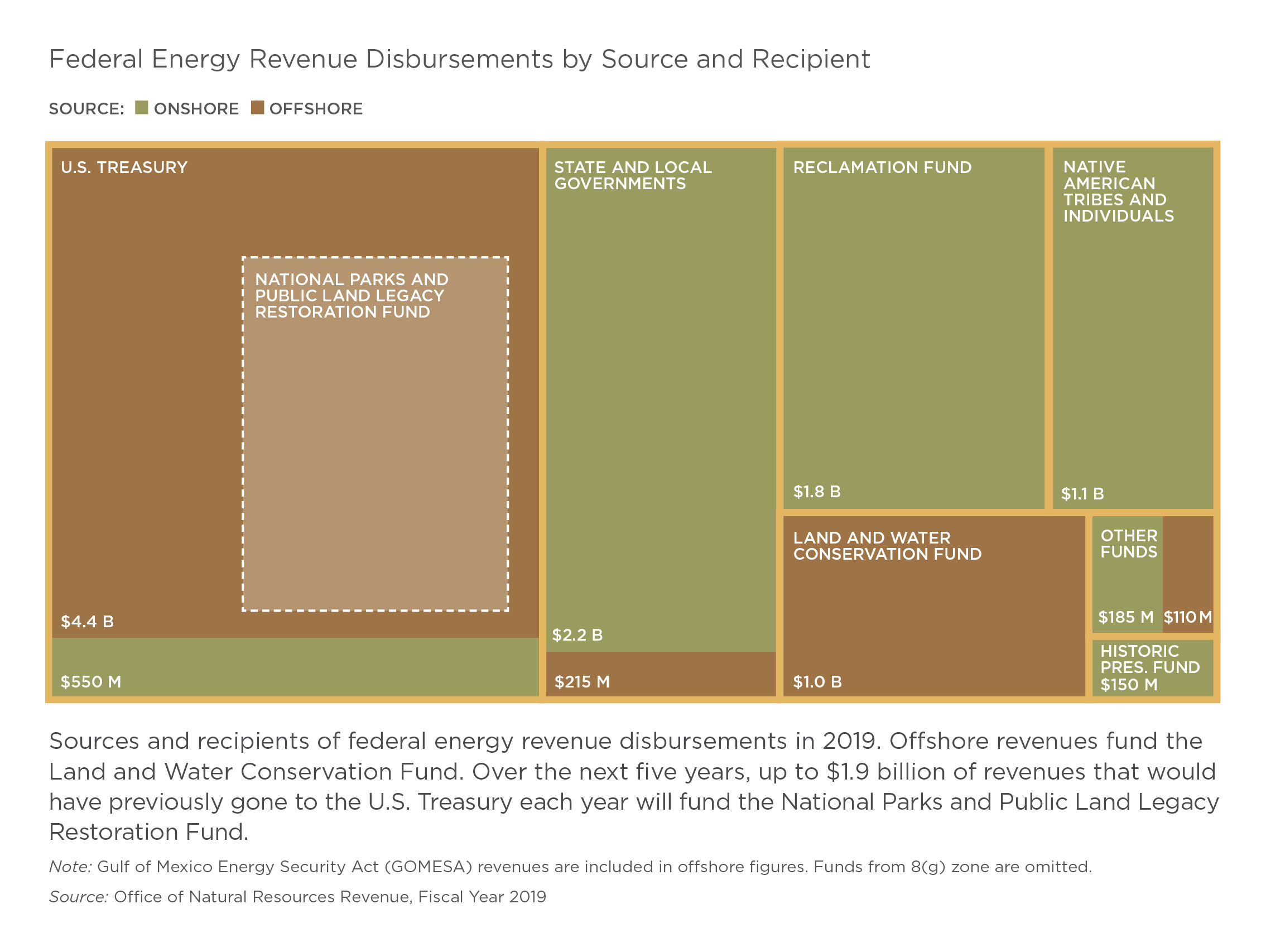DOWNLOAD THE FULL REPORT
Federal energy revenues, primarily from oil and gas leasing, have long provided a crucial source of funding for conservation and recreation on public lands. The recently passed Great American Outdoors Act further cements that approach. The act mandates full funding for the Land and Water Conservation Fund and creates the National Parks and Public Land Legacy Restoration Fund for deferred maintenance on public lands, both funded by federal energy revenues.
Several factors, however, threaten the viability of relying on energy revenues for conservation- and recreation-related programs, including competition over limited funds, unpredictability in energy markets, and uncertainty over the long-term political will for fossil fuel development on public lands and waters.
- Various federal programs and state and tribal governments already receive federal energy revenues, and more competition over funding will leave fewer receipts for conservation and recreation.
- Unpredictability in energy markets can compound the competition over revenues, rendering them unreliable. Federal energy revenues in three of the last four years would have been insufficient to fully fund the Legacy Restoration Fund, primarily due to low oil prices. Low oil prices over coming years could prevent the fund from receiving full funding.
- In the long run, calls to curtail or end oil and gas drilling on public lands and waters threatens funding reliant on such revenues, including funding for conservation and recreation.
In light of these issues, policymakers, conservationists, and recreationists would be wise to consider complementary or alternative sources of funds for conservation and recreation. User-based funding models have the greatest potential to reliably fund conservation and recreation in the long run.
User-funded models offer several advantages. For one, unlike existing programs dependent on energy revenues, funding tied to recreation demand does not have a mandated ceiling. Revenues from excise taxes paid and licenses purchased by hunters and anglers, for instance, generated roughly $2.6 billion for conservation purposes in 2019—far more than the $435 million in energy revenues that were appropriated to the LWCF, or even the $900 million that full funding would represent. Relatedly, if funding is directly linked to demand, then growth in the recreation economy would provide more resources to increase outdoor access and expand recreation opportunities. Lastly, a constituency that pays into the system has greater incentive and ability to hold policymakers and land managers accountable for using funds and stewarding public lands.
Recommendation:
- Establish a federal advisory committee to explore options for user-based models to fund conservation and recreation on public lands.
Threats to Conservation and Recreation Funding
Several factors threaten the model of using federal energy revenues to fund conservation and recreation programs.
Competition over revenues threatens funding.
Signed into law in August 2020, the Great American Outdoors Act mandated full annual funding of $900 million for the Land and Water Conservation Fund, the program that funds most federal land acquisition and provides grants to states for outdoor recreation purposes. The act also created the National Parks and Public Land Legacy Restoration Fund, a new program to address deferred maintenance on public lands.
Funding for both components of the act—the LWCF and the Legacy Restoration Fund—will rely on revenues from energy development on public lands and waters, portions of which are already obligated to various programs and entities. The LWCF is funded primarily by offshore energy receipts. Federal energy revenues also support the Reclamation Fund, the Historic Preservation fund, Native American tribes and individuals, and states. Once these existing obligations are funded, the leftover revenues, or “unobligated receipts,” from federal energy development are remitted to the general treasury and therefore become available for federal spending of any sort.
Until passage of the Great American Outdoors Act, all spending under the LWCF was discretionary, meaning that Congress had to appropriate spending for the program each year. Because unobligated federal energy revenues are made available for general spending, the LWCF has essentially competed with countless other government spending priorities since the day it passed—less money appropriated for the LWCF meant more general treasury revenue for spending on education, defense, social programs, and other federal purposes. In recent years, legislators appropriated less than half of the $900 million maximum allowed by the law, and in half a century the program rarely received full appropriation.
By also creating the Legacy Restoration Fund, the Great American Outdoors Act adds another competing program to draw upon federal energy revenues, albeit for a limited time. Beginning in fiscal year 2021, the restoration fund will receive half of unobligated energy receipts for five years, up to $1.9 billion per year. The bill, therefore, involves an inherent trade-off: Mandating full funding for the LWCF increases competition for previously unobligated energy receipts, which the restoration fund will rely on.
Likewise, there is potential for more competition over federal energy revenues on the horizon. The Recovering America’s Wildlife Act, a proposal that would permanently devote $1.3 billion of annual energy revenues to wildlife conservation, is one prominent example. Additionally, legislators from some Gulf States, which receive 37.5 percent of the energy revenues generated from certain leases in federal waters off their coasts, have repeatedly pushed to increase that share to 50 percent, which would match what interior states receive from drilling on federal land within their borders.
As long as federal energy revenues are flowing, there is little reason to think other legislators will not look to get a hold of the receipts for their own priorities in the future. “It’s long been a concern that it is viewed as this source that is not accounted for, and so therefore, it is available,” Senate Energy and Natural Resources Chairwoman Lisa Murkowski (R-Alaska) has said of the energy revenues. “And I think there are those who, in an effort to go after their project, will try to spend it multiple times over and it doesn’t work.”
In reality, a dollar spent on the LWCF, the deferred maintenance fund, or anything else means one less dollar available for any other federal program—and vice versa. Competition over scarce resources entails trade-offs. Given that the Legacy Restoration Fund relies on revenues not already obligated to other purposes, it could be left with less than full funding. Ultimately, more programs competing for federal energy revenues threatens to leave fewer receipts for conservation and recreation.
Volatility means unpredictability.
Because oil generates the majority of federal energy revenues, volatility in global oil markets introduces unpredictability for programs that rely on such revenues. Recent years demonstrate this reality and suggest how it could affect the Legacy Restoration Fund.
The restoration fund will receive half of onshore and offshore energy revenues that are left once all existing obligations are fulfilled, up to a maximum of $1.9 billion per year. That means at least $3.8 billion must be available above and beyond such obligations for the program to receive its full authorized amount. In three of the last four years, however, energy revenues would have been too meager to fully fund the program—largely due to low oil prices. The relatively low receipts from 2016 to 2018 demonstrate the volatility of energy revenues and how it can affect conservation and recreation funding. More recently, the spring 2020 crash of crude oil prices amidst the Covid-19 pandemic and dispute between Russia and Saudi Arabia reinforces how quickly energy revenues can fluctuate.
How much will is there to drill?
Over the long term, calls to restrict drilling on public lands and waters make federal oil and gas revenues an uncertain source of funding. In particular, recent calls to ban offshore oil and gas drilling—which generates roughly half of all federal energy revenues—could threaten the long-run reliability of the Land and Water Conservation Fund.
Every major Democratic candidate for the 2020 presidential primary pledged to ban new fossil fuel drilling on federal property, including offshore waters. As the eventual nominee, Joe Biden pledged to ban new oil and gas leasing on public lands and waters. Curtailing fossil fuel production on federal property has become a mainstream Democratic stance, a policy that is already being pursued via the legislative process.
Banning new fossil fuel energy leases would not immediately decimate energy revenues. Drilled wells would continue to produce, but once existing leases expired, the effects on federal energy revenue would be significant. When it comes to offshore energy in particular, the National Ocean Industries Association estimates that if new offshore drilling were banned in 2022, it would reduce average offshore energy revenues by 61 percent by 2040, from $7.0 billion to $2.7 billion. If offshore revenues were to fall that drastically, then funding for the LWCF—as well as any other federal conservation and recreation programs dependent on energy revenues—would be under threat.
Funding Conservation and Recreation for the 21st Century
Policymakers have clear reason to reckon with the drawbacks of using fossil fuel revenue to fund conservation and recreation. Conservationists and recreationists uncomfortable with the status quo also have an incentive to reconsider where funding will come from in the decades ahead. While renewable energy revenues might offer an option, public land users are the most promising backers of funding.
Can revenue from renewables replace revenue from fossil fuels?
Replacing federal revenues from oil and gas development with those from solar and wind production could eventually be an option. The Bureau of Land Management manages more than 19 million acres of public land that the agency deems to have “excellent” solar potential, and U.S. offshore wind energy potential is immense—nearly double the amount of electricity the country uses today, according to a wind trade association. The question is how quickly solar and wind on federal lands can reach their potential. If all currently designated solar energy zones on public lands were eventually built out, they would generate estimated annual revenues of $116 million, though the amount of time that would take is unclear. The Department of Energy estimates that by 2050, offshore wind development can quadruple the capacity of currently approved projects. That would be enormous growth, but it would yield only approximately $431 million per year—less than halfway to fully funding the LWCF, let alone all of the other federal spending currently supported by energy revenues.
There is little doubt that wind and solar energy will provide an increasing stream of federal revenue in coming decades. But it is clear that the federal revenues generated from those sources will not rival fossil fuel energy’s soon, and solar and wind face their own challenges that could delay or curtail their development on public lands and waters or make them unappealing sources of conservation funding. Solar development has controversial effects on wildlife habitat, and offshore wind projects have been repeatedly stymied by environmental impact assessments, concerns for fisheries and birds, and “not-in-my-backyard” protests from coastal communities. To be sure, fossil energy development brings its own range of environmental impacts, but effects of any type of energy development on habitat and wildlife should be weighed when considering it as a potential source of conservation and recreation funding.
User-based revenues represent a better way forward.
Policymakers, conservationists, and recreationists should consider user-based funding mechanisms for conservation and recreation. Hunters and anglers already finance a great deal of wildlife conservation at the state level. Revenues from hunting and fishing licenses amount to roughly $1.6 billion annually. On top of that, revenues from excise taxes paid on purchases of firearms, ammunition, fishing tackle, boat fuel, and related gear bring in an additional $1.0 billion each year. These revenues are directed to state fish and wildlife agencies to increase outdoor recreation access, protect wildlife habitat, and fund other purposes dedicated to recreation and wildlife conservation, and there is no mandated annual cap on such user-generated funds. Together, they provide nearly three times as many resources each year as a fully funded LWCF program will.
There is great potential for a user-based funding model given the strength of the outdoor recreation economy. The Bureau of Economic Analysis estimates the value of the outdoor recreation economy at $427 billion. Over the long term, tying funding to recreation demand would be a smart approach. Currently, funding for the LWCF is not directly linked to that demand—as state wildlife conservation funding is with hunters and anglers. If funding were tied to demand, then growth in the recreation economy would equate to more resources to increase outdoor access, conserve land and habitat, or expand recreation opportunities.
The original goal of the Land and Water Conservation Fund Act was to provide recreation opportunities to all Americans. Linking its funding to the hikers, paddlers, climbers, mountain bikers, wildlife watchers, and other recreationists who benefit from the program would be in keeping with that goal. Recreationists might also be able to hold politicians more accountable for spending decisions given that they would bring substantial resources to bear on public land funding. Because user-based funding is tied to recreationists, a clear constituency exists to promote responsible use of such funds and encourage stewardship of the public lands that serve as some of our greatest recreation assets.
Exploring Options for a User-Based Revenue Model
User-based funding for conservation and recreation would circumvent the short- and long-term concerns of relying on energy revenues. Ultimately, it would also be in the interest of recreationists to contribute directly.
Recommendation:
Establish a federal advisory committee to explore options for user-based models to fund conservation and recreation on public lands.
The potential funding challenges presented by the current model warrant innovative and creative ideas about user-funded alternatives. A group with representation from recreationists, conservation groups, outdoor industry, and related parties could explore the most promising approaches for users to finance conservation and recreation on public lands. It could weigh trade-offs of various approaches, including ones that mimic the system of hunting and fishing licenses, expansion or improvement of recreation fees like those already charged at certain public lands, gear taxes such as those paid on purchases of firearms and tackle, or other options. The federal advisory committee model provides a straightforward way to form such a group with appropriate representation and a clear remit to investigate the most promising alternatives.
The committee could also explore the feasibility of channeling user-generated dollars through existing programs such as the LWCF or the newly created National Parks and Public Land Legacy Restoration Fund. While the restoration fund will provide billions of dollars for deferred maintenance projects over the next five years, appropriators have yet to solve the underlying maintenance issues that spawned the backlog—a lack of funding to address routine maintenance. The advisory committee could investigate ways that user-funded models could continue to support the Legacy Restoration Fund beyond its initial five years, as well as ways to diversify its funding to address a wider array of recreation and conservation needs.
Arguably, recreationists and conservationists would benefit the most from unshackling funding from energy revenues. Establishing a federal advisory committee could be an initial step toward finding a user-based model that can provide the resources necessary to steward our public lands for future generations.








